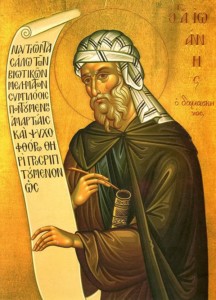St John of Damascus
On the Resurrection

In the Exact Exposition of the Christian Faith, St John of Damascus (675-749) takes readers methodically through Orthodox dogma and enhances our understanding of much of what is often taken for granted. This is particularly evident in Books 3 and 4 where he elaborates on what actually happened at the Resurrection.
A key focus of St John is that Christ took on “death on our behalf” in both of His natures: human and divine. Death did not corrupt Christ’s body. It was a normal human body subject to the wounds of the flesh such as: hunger, thirst; weariness; the piercing with nails; and death, but it did not rot like a normal human body. This is the same as the human body when holiness is present, as evidenced by the incorrupt remains (Holy Relics) of many saints, some of whom have wholly intact bodies.
St John also explains why Christ’s human body was so different after the Resurrection. It was not bound by any of the needs which we have in our fallen state, like hunger or thirst. It was the same body with none of the previous human frailties.
Christ took on our “curse and desertion” – the unnatural consequence of the Fall – yet did not Himself fall into it. He offered Himself to the Father on our behalf. He was not offered to sin, Hades or, as St John puts it: “God forbid … the Tyrant.” He was offered as a “ransom”, to Him whom we humans had sinned against.
Christ then descended into Hades, with St John teaching that Christ did in Hades what He did in His earthly ministry by bringing “light to those who sit under the earth in darkness and the shadow of death.”
But death could not contain Christ, the Source of Life. As St John writes: “For just as darkness disappears on the introduction of light, so is death repulsed before the assault of life, and brings life to all, but death to the destroyer.”
Source: Lychnos April-May 2020
